Mapping Alkaline Fens, Transition Mires and Quaking Bogs Using Airborne Hyperspectral and Laser Scanning Data
Abstract
1. Introduction
2. Materials and Methods
2.1. Study Areas and Examined Habitats
2.2. Remote Sensing Data
2.3. Botanical Reference Data
2.4. Classification and Accuracy Assessment
3. Results
3.1. Results at Level 1 of Classification Scenarios
3.2. Results at Level 2 of Classification Scenarios
3.3. Results at Level 3 of Classification Scenarios—A Selection of Sub-Products
4. Discussion
4.1. Products and Classification Accuracies
4.2. Optimal Term for Data Acquisition
5. Conclusions
Author Contributions
Funding
Acknowledgments
Conflicts of Interest
References
- Okruszko, T. Kryteria Hydrologiczne w Ochronie Mokradeł. In Rozprawy Naukowe i Monografie; Wydawnictwo SGGW: Warszawa, Poland, 2005. (In Polish) [Google Scholar]
- Mitsch, W.J.; Gosselink, J.G. The value of wetlands: Importance of scale and landscape setting. Ecol. Econ. 2000, 35, 25–33. [Google Scholar] [CrossRef]
- Mitsch, W.J.; Bernal, B.; Hernandez, M.E. Ecosystem services of wetlands. Int. J. Biodivers. Sci. Ecosyst. Serv. Manag. 2015, 11, 1–4. [Google Scholar] [CrossRef]
- Maltby, E. Functional Assessment of Wetlands: Toward Evaluation of Ecosystem Services; Woodhead Publishing: Sawston, Cam-bridge, UK, 2009. [Google Scholar]
- Maltby, E.; Acreman, M.C. Ecosystem services of wetlands: Pathfinder for a new paradigm. Hydrol. Sci. J. 2011, 56, 1341–1359. [Google Scholar] [CrossRef]
- Chasmer, L.; Mahoney, C.; Millard, K.; Nelson, K.; Peters, D.; Merchant, M.; Hopkinson, C.; Brisco, B.; Niemann, O.; Montgomery, J.; et al. Remote Sensing of Boreal Wetlands 2: Methods for Evaluating Boreal Wetland Ecosystem State and Drivers of Change. Remote Sens. 2020, 12, 1321. [Google Scholar] [CrossRef]
- Mitsch, W.J.; Gosselink, J.G. Wetlands 1993, 2nd ed.; John Wiley: Hoboken, NJ, USA, 1993. [Google Scholar]
- Council Directive 92/43/EEC of 21 May 1992 on the conservation of natural habitats and of wild fauna and flora. Off. J. Eur. Union 1992, 206, 7–50.
- Firbank, L.; Barr, C.; Bunce, R.; Furse, M.; Haines-Young, R.; Hornung, M.; Howard, D.; Sheail, J.; Sier, A.; Smart, S. Assessing stock and change in land cover and biodiversity in GB: An introduction to Countryside Survey 2000. J. Environ. Manag. 2003, 67, 207–218. [Google Scholar] [CrossRef]
- Bloch-Petersen, M.; Brandt, J.; Olsen, M. Integration of European habitat monitoring based on plant life form composition as an indicator of environmental change and change in biodiversity. Geogr. Tidsskr. J. Geogr. 2006, 106, 61–74. [Google Scholar] [CrossRef]
- Lengyel, S.; Déri, E.; Varga, Z.; Horváth, R.; Tóthmérész, B.; Henry, P.-Y.; Kobler, A.; Kutnar, L.; Babij, V.; Seliškar, A.; et al. Habitat monitoring in Europe: A description of current practices. Biodivers. Conserv. 2008, 17, 3327–3339. [Google Scholar] [CrossRef]
- Feilhauer, H.; Dahlke, C.; Doktor, D.; Lausch, A.; Schmidtlein, S.; Schulz, G.; Stenzel, S. Mapping the local variability of Natura 2000 habitats with remote sensing. Appl. Veg. Sci. 2014, 17, 765–779. [Google Scholar] [CrossRef]
- Lafage, D.; Bonis, A.; Rapinel, S.; Bouzille, J.-B. Using landscape metrics on satellite imagery to assess conservation status of Natura 2000 habitats. Documents phytosociologiques—Actes du colloque de Saint-Mandé 2012. In Prodrome et Cartographie des Végétations de France; Actes du Colloque de Saint-Mandé: Saint Mandé, France, 2017; Volume 6, pp. 395–411. [Google Scholar]
- EEA. Terrestrial Habitat Mapping in EUROPE: An Overview; EEA Technical Report; Joint MNHN-EEA Report; European Environment Agency—EEA, Publications Office of the European Union: Luxembourg, 2014; ISSN 1725-2237.
- Borre, J.V.; Paelinckx, D.; Mücher, C.A.; Kooistra, L.; Haest, B.; De Blust, G.; Schmidt, A.M. Integrating remote sensing in Natura 2000 habitat monitoring: Prospects on the way forward. J. Nat. Conserv. 2011, 19, 116–125. [Google Scholar] [CrossRef]
- Hopkinson, C.; Chasmer, L.E.; Sass, G.; Creed, I.F.; Sitar, M.; Kalbfleisch, W.; Treitz, P. Vegetation class dependent errors in lidar ground elevation and canopy height estimates in a boreal wetland environment. Can. J. Remote Sens. 2005, 31, 191–206. [Google Scholar] [CrossRef]
- Bässler, C.; Stadler, J.; Müller, J.; Förster, B.; Göttlein, A.; Brandl, R. LiDAR as a rapid tool to predict forest habitat types in Natura 2000 networks. Biodivers. Conserv. 2010, 20, 465–481. [Google Scholar] [CrossRef]
- Alexander, C.; Deák, B.; Kania, A.; Mücke, W.; Heilmeier, H. Classification of vegetation in an open landscape using full-waveform airborne laser scanner data. Int. J. Appl. Earth Obs. Geoinf. 2015, 41, 76–87. [Google Scholar] [CrossRef]
- Rosso, P.; Ustin, S.; Hastings, A. Use of lidar to study changes associated with Spartina invasion in San Francisco Bay marshes. Remote Sens. Environ. 2006, 100, 295–306. [Google Scholar] [CrossRef]
- Schmid, K.A.; Hadley, B.C.; Wijekoon, N. Vertical Accuracy and Use of Topographic LIDAR Data in Coastal Marshes. J. Coast. Res. 2011, 275, 116–132. [Google Scholar] [CrossRef]
- Hladik, C.; Alber, M. Accuracy assessment and correction of a LIDAR-derived salt marsh digital elevation model. Remote Sens. Environ. 2012, 121, 224–235. [Google Scholar] [CrossRef]
- Fernandez-Nunez, M.; Burningham, H.; Zujar, J.O. Improving accuracy of LiDAR-derived digital terrain models for saltmarsh management. J. Coast. Conserv. 2017, 21, 209–222. [Google Scholar] [CrossRef]
- Hopkinson, C.; Lovell, J.; Chasmer, L.; Jupp, D.; Kljun, N.; van Gorsel, E. Integrating terrestrial and airborne lidar to calibrate a 3D canopy model of effective leaf area index. Remote Sens. Environ. 2013, 136, 301–314. [Google Scholar] [CrossRef]
- Demarchi, L.; Kania, A.; Ciężkowski, W.; Piórkowski, H.; Oświecimska-Piasko, Z.; Chormański, J. Recursive Feature Elimination and Random Forest Classification of Natura 2000 Grasslands in Lowland River Valleys of Poland Based on Airborne Hyperspectral and LiDAR Data Fusion. Remote Sens. 2020, 12, 1842. [Google Scholar] [CrossRef]
- Kopeć, D.; Michalska-Hejduk, D.; Sławik, Ł.; Berezowski, T.; Borowski, M.; Rosadziński, S.; Chormański, J. Application of multisensoral remote sensing data in the mapping of alkaline fens Natura 2000 habitat. Ecol. Indic. 2016, 70, 196–208. [Google Scholar] [CrossRef]
- Zhang, J. Multi-source remote sensing data fusion: Status and trends. Int. J. Image Data Fusion 2010, 1, 5–24. [Google Scholar] [CrossRef]
- Sławik, Ł.; Niedzielko, J.; Kania, A.; Piórkowski, H.; Kopeć, D. Multiple Flights or Single Flight Instrument Fusion of Hyperspectral and ALS Data? A Comparison of their Performance for Vegetation Mapping. Remote Sens. 2019, 11, 970. [Google Scholar] [CrossRef]
- Maltby, E.; Barker, T. The Wetlands Handbook 2009; John Wiley & Sons: Hoboken, NJ, USA, 2009. [Google Scholar]
- Bork, E.W.; Su, J.G. Integrating LIDAR data and multispectral imagery for enhanced classification of rangeland vegetation: A meta analysis. Remote Sens. Environ. 2007, 111, 11–24. [Google Scholar] [CrossRef]
- Gilmore, M.S.; Wilson, E.H.; Barrett, N.; Civco, D.L.; Prisloe, S.; Hurd, J.D.; Chadwick, C. Integrating multi-temporal spectral and structural information to map wetland vegetation in a lower Connecticut River tidal marsh. Remote Sens. Environ. 2008, 112, 4048–4060. [Google Scholar] [CrossRef]
- Hladik, C.M.; Schalles, J.F.; Alber, M. Salt marsh elevation and habitat mapping using hyperspectral and LIDAR data. Remote Sens. Environ. 2013, 139, 318–330. [Google Scholar] [CrossRef]
- Rapinel, S.; Hubert-Moy, L.; Clément, B. Combined use of LiDAR data and multispectral earth observation imagery for wetland habitat mapping. Int. J. Appl. Earth Obs. Geoinf. 2015, 37, 56–64. [Google Scholar] [CrossRef]
- Zhang, C.; Denka, S.; Mishra, D.R. Mapping freshwater marsh species in the wetlands of Lake Okeechobee using very high-resolution aerial photography and lidar data. Int. J. Remote Sens. 2018, 39, 5600–5618. [Google Scholar] [CrossRef]
- Chasmer, L.; Hopkinson, C.; Veness, T.; Quinton, W.; Baltzer, J. A decision-tree classification for low-lying complex land cover types within the zone of discontinuous permafrost. Remote Sens. Environ. 2014, 143, 73–84. [Google Scholar] [CrossRef]
- Berhane, T.M.; Lane, C.R.; Wu, Q.; Autrey, B.C.; Anenkhonov, O.A.; Chepinoga, V.V.; Liu, H. Decision-Tree, Rule-Based, and Random Forest Classification of High-Resolution Multispectral Imagery for Wetland Mapping and Inventory. Remote Sens. 2018, 10, 580. [Google Scholar] [CrossRef] [PubMed]
- McCarthy, M.J.; Radabaugh, K.R.; Moyer, R.P.; Muller-Karger, F.E. Enabling efficient, large-scale high-spatial resolution wet-land mapping using satellites. Remote Sens. Environ. 2018, 208, 189–201. [Google Scholar] [CrossRef]
- Sanchez-Hernandez, C.; Boyd, D.S.; Foody, G.M. One-Class Classification for Mapping a Specific Land-Cover Class: SVDD Classification of Fenland. IEEE Trans. Geosci. Remote Sens. 2007, 45, 1061–1073. [Google Scholar] [CrossRef]
- Sanchez-Hernandez, C.; Boyd, D.S.; Foody, G.M. Mapping specific habitats from remotely sensed imagery: Support vector machine and support vector data description based classification of coastal saltmarsh habitats. Ecol. Inform. 2007, 2, 83–88. [Google Scholar] [CrossRef]
- MacAlister, C.; Mahaxay, M. Mapping wetlands in the Lower Mekong Basin for wetland resource and conservation man-agement using Landsat ETM images and field survey data. J. Environ. Manag. 2009, 90, 2130–2137. [Google Scholar] [CrossRef]
- Collin, A.; Long, B.; Archambault, P. Salt-marsh characterization, zonation assessment and mapping through a du-al-wavelength LiDAR. Remote Sens. Environ. 2010, 114, 520–530. [Google Scholar] [CrossRef]
- Onojeghuo, A.O.; Blackburn, G.A. Optimising the use of hyperspectral and LiDAR data for mapping reedbed habitats. Remote Sens. Environ. 2011, 115, 2025–2034. [Google Scholar] [CrossRef]
- Alexandridis, T.K.; Lazaridou, E.; Tsirika, A.; Zalidis, G.C. Using Earth Observation to update a Natura 2000 habitat map for a wetland in Greece. J. Environ. Manag. 2009, 90, 2243–2251. [Google Scholar] [CrossRef]
- Wagner-Lücker, I.; Lanz, E.; Forster, M.; Janauer, G.A.; Reiter, K. Knowledge-based framework for delineation and classification of ephemeral plant communities in riverine landscapes to support EC Habitat Directive assessment. Ecol. Inform. 2013, 14, 44–47. [Google Scholar] [CrossRef]
- Bochenek, Z.; Shrestha, S.; Małek, I. Hybrid approach for mapping wetland habitats based on application of VHR satellite images. Geoinf. Issues 2013, 5, 21–28. [Google Scholar]
- Mui, A.; He, Y.; Weng, Q. An object-based approach to delineate wetlands across landscapes of varied disturbance with high spatial resolution satellite imagery. ISPRS J. Photogramm. Remote Sens. 2015, 109, 30–46. [Google Scholar] [CrossRef]
- Jeong, S.G.; Mo, Y.; Kim, H.G.; Park, C.H.; Lee, D.K. Mapping riparian habitat using a combination ofremote-sensing techniques. Int. J. Remote Sens. 2016, 37, 1069–1088. [Google Scholar] [CrossRef]
- Rapinel, S.; Mony, C.; Lecoq, L.; Clément, B.; Thomas, A.; Hubert-Moy, L. Evaluation of Sentinel-2 time-series for mapping floodplain grassland plant communities. Remote Sens. Environ. 2019, 223, 115–129. [Google Scholar] [CrossRef]
- Morris, J.T.; Porter, D.; Neet, M.; Noble, P.A.; Schmidt, L.; Lapine, L.A.; Jensen, J.R. Integrating LIDAR elevation data, multi-spectral imagery and neural network modelling for marsh characterization. Int. J. Remote Sens. 2005, 26, 5221–5234. [Google Scholar] [CrossRef]
- Collin, A.; Lambert, N.; Etienne, S. Satellite-based salt marsh elevation, vegetation height, and species composition mapping using the superspectral WorldView-3 imagery. Int. J. Remote Sens. 2018, 39, 5619–5637. [Google Scholar] [CrossRef]
- Van Beijma, S.; Comber, A.; Lamb, A. Random forest classification of salt marsh vegetation habitats using quad-polarimetric airborne SAR, elevation and optical RS data. Remote Sens. Environ. 2014, 149, 118–129. [Google Scholar] [CrossRef]
- Zlinszky, A.; Deák, B.; Kania, A.; Schroiff, A.; Pfeifer, N. Biodiversity mapping via Natura 2000 conservation status and EBV assessment using airborne laser scanning in alkali grasslands. Int. Arch. Photogramm. Remote Sens. Spat. Inf. Sci. 2016, XLI–B8, 1293. [Google Scholar] [CrossRef]
- Wendelberger, K.S.; Gann, D.; Richards, J.H. Using Bi-Seasonal WorldView-2 Multi-Spectral Data and Supervised Random Forest Classification to Map Coastal Plant Communities in Everglades National Park. Sensors 2018, 18, 829. [Google Scholar] [CrossRef]
- Al-Jarrah, O.; Siddiqui, A.; ElSalamouny, M.; Yoo, P.; Muhaidat, S.; Kim, K. Machine-Learning-Based Feature Selection Techniques for Large-Scale Network Intrusion Detection. In Proceedings of the 2014 IEEE 34th International Conference on Distributed Computing Systems Workshops, Madrid, Spain, 30 June–3 July 2014; pp. 177–181. [Google Scholar]
- Zlinszky, A.; Deák, B.; Kania, A.; Schroiff, A.; Pfeifer, N. Mapping Natura 2000 Habitat Conservation Status in a Pannonic Salt Steppe with Airborne Laser Scanning. Remote Sens. 2015, 7, 2991–3019. [Google Scholar] [CrossRef]
- Marcinkowska-Ochtyra, A.; Gryguc, K.; Ochtyra, A.; Kopeć, D.; Jarocińska, A.; Sławik, Ł. Multitemporal Hyperspectral Data Fusion with Topographic Indices—Improving Classification of Natura 2000 Grassland Habitats. Remote Sens. 2019, 11, 2264. [Google Scholar] [CrossRef]
- Wołejko, L.; Stańko, R.; Pawlikowski, P.; Jarzombkowski, F.; Kiaszewicz, K.; Chapiński, P.; Bregin, M.; Kozub, Ł.; Krajewski, Ł.; Szczepański, M. Krajowy Program Ochrony Torfowisk Alkalicznych (7230); Wydawnictwo Klubu Przyrodników: Świebodzin, Poland, 2012. (In Polish) [Google Scholar]
- Jarzombkowski, F. Torfowiska w Basenie Górnym doliny Biebrzy. W: A. Obidziński (red.) Z Mazowsza na Polesie i Wileńszczyznę. Zróżnicowanie i Ochrona Szaty Roślinnej Pogranicza Europy Środkowej i Północno-Wschodniej. 2010, pp. 331–340. Available online: https://bagna.pl/images/biblioteczka/z_Mazowsza_na_Polesie_i_Wilenszczyzne.pdf (accessed on 1 October 2019). (In Polish).
- Norsk Elektro Optikk. Hyperspectral Imaging Systems. Available online: www.hyspex.no (accessed on 1 October 2019).
- ReSe Applications LLC, Switzerland. Available online: https://www.rese-apps.com (accessed on 1 October 2019).
- Cristóbal, J.; Graham, P.; Prakash, A.; Buchhorn, M.; Gens, R.; Guldager, N.; Bertram, M. Airborne Hyperspectral Data Acquisition and Processing in the Arctic: A Pilot Study Using the Hyspex Imaging Spectrometer for Wetland Mapping. Remote Sens. 2021, 13, 1178. [Google Scholar] [CrossRef]
- ASD Inc., Longmont, CO, USA. Malvern Panalytical Ltd. Is a Spectris Company. Available online: https://www.malvernpanalytical.com/en (accessed on 1 October 2019).
- Boardman, J.W.; Kruse, F.A. Automated Spectral Analysis: A Geological Example Using AVIRIS Data, North Grapevine Moun-Tains, Nevada. In Proceedings of the ERIM Tenth Thematic Conference on Geologic Remote Sensing, San Antonio, TX, USA, 9–12 May 1994; Environmental Research Institute of Michigan: Ann Arbor, MI, USA, 1994. [Google Scholar]
- Harris Geospatial Solutions, Inc. Available online: https://www.l3harrisgeospatial.com (accessed on 1 October 2019).
- RIEGL Laser Measurement Systems GmbH. Available online: www.riegl.com (accessed on 1 October 2019).
- Terrasolid Ltd. Available online: https://terrasolid.com (accessed on 1 October 2019).
- Mandlburger, G.; Otepka, J.; Karel, W.; Wagner, W.; Pfeifer, N. Orientation and Processing of Airborne Laser Scanning. In ISPRS Workshop Laserscanning; Technische Universität: Wien, Vienna, Austria, 2009; Available online: https://opals.geo.tuwien.ac.at/html/stable/index.html (accessed on 1 October 2019).
- Mallet, C.; Bretar, F. Full-waveform topographic lidar: State-of-the-art. ISPRS J. Photogramm. Remote Sens. 2009, 64, 1–16. [Google Scholar] [CrossRef]
- System for Automated Geoscientific Analyses. Available online: http://www.saga-gis.org/en/index.html (accessed on 1 October 2019).
- Halladin-Dąbrowska, A.; Kania, A.; Kopeć, D. The t-SNE Algorithm as a Tool to Improve the Quality of Reference Data Used in Accurate Mapping of Heterogeneous Non-Forest Vegetation. Remote Sens. 2019, 12, 39. [Google Scholar] [CrossRef]
- Breiman, L. Random Forests. In Machine Learning; Kluwer Academic Publishers: Amsterdam, The Netherlands, 2001; Volume 45, pp. 5–32. [Google Scholar]
- Rodriguez-Galiano, V.F.; Ghimire, B.; Rogan, J.; Chica-Olmo, M.; Rigol-Sanchez, J.P. An assessment of the effectiveness of a random forest classifier for land-cover classification. ISPRS J. Photogramm. Remote Sens. 2012, 67, 93–104. [Google Scholar] [CrossRef]
- Gallant, J.C.; Dowling, T.I. A multiresolution index of valley bottom flatness for mapping depositional areas. Water Resour. Res. 2003, 39, 1347–1360. [Google Scholar] [CrossRef]
- Boehner, J.; Antonic, O. Land Surface Parameters Specific to Topo-Climatology. Dev. Soil Sci. 2009, 33, 195–226. [Google Scholar]
- Guisan, A.; Weiss, S.B.; Weiss, A.D. GLM versus CCA spatial modeling of plant species distribution. Plant Ecol. 1999, 143, 107–122. [Google Scholar] [CrossRef]
- Boehner, J.; Selige, T. Spatial prediction of soil attributes using terrain analysis and climate regionalisation. In SAGA—Analysis and Modelling Applications; Boehner, J., McCloy, K.R., Strobl, J., Eds.; Goettinger Geographische Abhandlungen: Goettingen, Germany, 2006; pp. 13–28. [Google Scholar]
- Boehner, J.; Koethe, R.; Conrad, O.; Gross, J.; Ringeler, A.; Selige, T. Soil Regionalisation by Means of Terrain Analysis and Process Parameterisation. In Soil Classification 2001; Micheli, E., Nachtergaele, F.O., Jones, R.J.A., Montanarella, L., Eds.; European Soil Bureau Research Report No.7, EUR 20398 EN; Office for Official Publications of the European Communities: Luxembourg, 2002; pp. 213–222. [Google Scholar]
- Gitelson, A.; Merzlyak, M.; Chivkunova, O. Optical Properties and Nondestructive Estimation of Anthocyanin Content in Plant Leaves. Photochem. Photobiol. 2001, 74, 38–45. [Google Scholar] [CrossRef]
- Huete, A.; Didan, K.; Miura, T.; Rodriguez, E.P.; Gao, X.; Ferreira, L.G. Overview of the Radiometric and Biophysical Per-formance of the MODIS Vegetation Indices. Remote Sens. Environ. 2002, 83, 195–213. [Google Scholar] [CrossRef]
- Penuelas, J.; Baret, F.; Filella, I. Semi-Empirical Indices to Assess Carotenoids/Chlorophyll-a Ratio from Leaf Spectral Reflec-tance. Photosynthetica 1995, 31, 221–230. [Google Scholar]
- Penuelas, J.; Filella, I.; Gamon, J.A. Assessment of photosynthetic radiation-use efficiency with spectral reflectance. New Phytol. 1995, 131, 291–296. [Google Scholar] [CrossRef]
- McFeeters, S.K. The use of the Normalized Difference Water Index (NDWI) in the delineation of open water features. Int. J. Remote Sens. 1996, 17, 1425–1432. [Google Scholar] [CrossRef]
- Xu, H. Modification of normalised difference water index (NDWI) to enhance open water features in remotely sensed imagery. Int. J. Remote Sens. 2006, 27, 3025–3033. [Google Scholar] [CrossRef]
- Gitelson, A.; Merzlyak, M.N. Spectral Reflectance Changes Associated with Autumn Senescence of Aesculus hippocastanum L. and Acer platanoides L. Leaves. Spectral Features and Relation to Chlorophyll Estimation. J. Plant Physiol. 1994, 143, 286–292. [Google Scholar] [CrossRef]
- Sims, D.; Gamon, J. Relationships between Leaf Pigment Content and Spectral Reflectance across a Wide Range of Species, Leaf Structures and Developmental Stages. Remote Sens. Environ. 2002, 81, 337–354. [Google Scholar] [CrossRef]
- Bernstein, L.S.; Jin, X.; Gregor, B.; Adler-Golden, S.M. Quick atmospheric correction code: Algorithm description and recent upgrades. Opt. Eng. 2012, 51, 111719. [Google Scholar] [CrossRef]
- Wang, L.; Qu, J.J. NMDI: A normalized multi-band drought index for monitoring soil and vegetation moisture with satellite remote sensing. Geophys. Res. Lett. 2007, 34, 20405. [Google Scholar] [CrossRef]
- Wang, L.; Qu, J.J.; Hao, X. Forest fire detection using the normalized multi-band drought index (NMDI) with satellite measurements. Agric. For. Meteorol. 2008, 148, 1767–1776. [Google Scholar] [CrossRef]
- Segal, D. Theoretical Basis for Differentiation of Ferric-Iron Bearing Minerals, Using Landsat MSS Data. In Proceedings of the Symposium for Remote Sensing of Environment 1982, 2nd Thematic Conference on Remote Sensing for Exploratory Geology, Fort Worth, TX, USA, 6–10 December 1982; Environmental Research Institute of Michigan: Ann Arbor, MI, USA, 1982; pp. 949–951. [Google Scholar]
- Drury, S.A. Image interpretation in geology. Geocarto Int. 1987, 2, 48. [Google Scholar] [CrossRef]
- Tucker, C.J. Red and photographic infrared linear combinations for monitoring vegetation. Remote Sens. Environ. 1979, 8, 127–150. [Google Scholar] [CrossRef]
- Daughtry, C. Discriminating Crop Residues from Soil by Short-Wave Infrared Reflectance. Agron. J. 2001, 93, 125–131. [Google Scholar] [CrossRef]
- Daughtry, C.E.; Hunt, E.R., Jr.; McMurtrey, J., III. Assessing Crop Residue Cover Using Shortwave Infrared Reflectance. Remote Sens. Environ. 2004, 90, 126–134. [Google Scholar] [CrossRef]
- Kaufman, Y.; Tanre, D. Atmospherically resistant vegetation index (ARVI) for EOS-MODIS. IEEE Trans. Geosci. Remote Sens. 1992, 30, 261–270. [Google Scholar] [CrossRef]
- Liu, X.; Zhang, B.; Gao, L.; Chen, N. A maximum noise fraction transform with improved noise estimation for hyperspectral images. Sci. China Ser. F Inf. Sci. 2009, 52, 1578–1587. [Google Scholar] [CrossRef]
- Brasil. Decreto—Lei n° 227, de 28 de Fevereiro de 1967. Dá nova Redação ao Decreto-lei nº 1.985, de 29 de Janeiro de 1940 (Código de Minas). Brasília. 1967. Available online: http://www.planalto.gov.br/ccivil_03/Decreto-Lei/Del0227.htm (accessed on 19 October 2020).
- Riley, J.W.; Calhoun, D.L.; Barichivich, W.J.; Walls, S.C. Identifying Small Depressional Wetlands and Using a Topographic Position Index to Infer Hydroperiod Regimes for Pond-Breeding Amphibians. Wetlands 2017, 37, 325–338. [Google Scholar] [CrossRef]
- García-Rivero, A.E.; Olivera, J.; Salinas, E.; Yuli, R.A.; Bulege, W. Use of Hydrogeomorphic Indexes in SAGA-GIS for the Characterization of Flooded Areas in Madre de Dios, Peru. Int. J. Appl. Eng. Res. 2017, 12, 9078–9086. [Google Scholar]

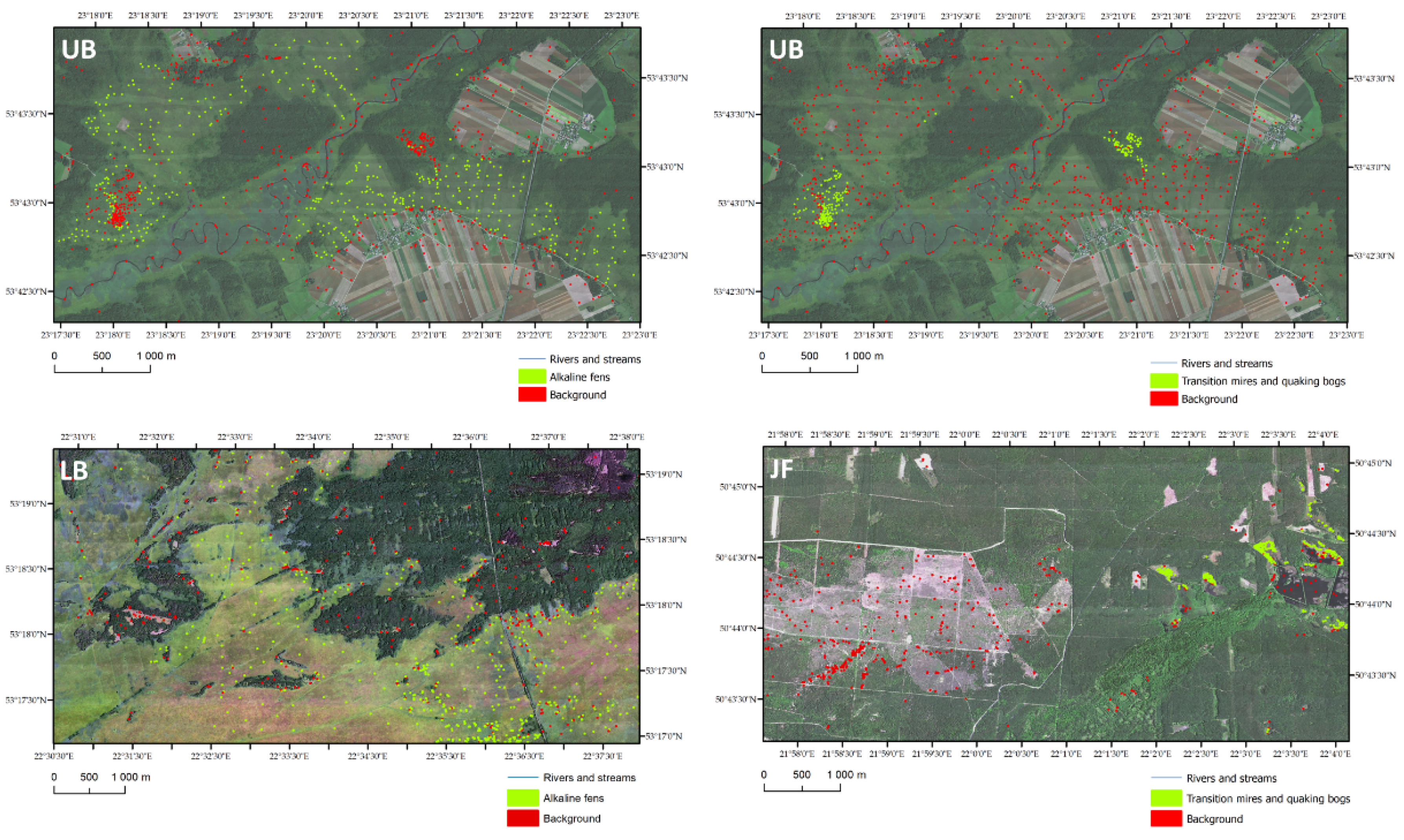
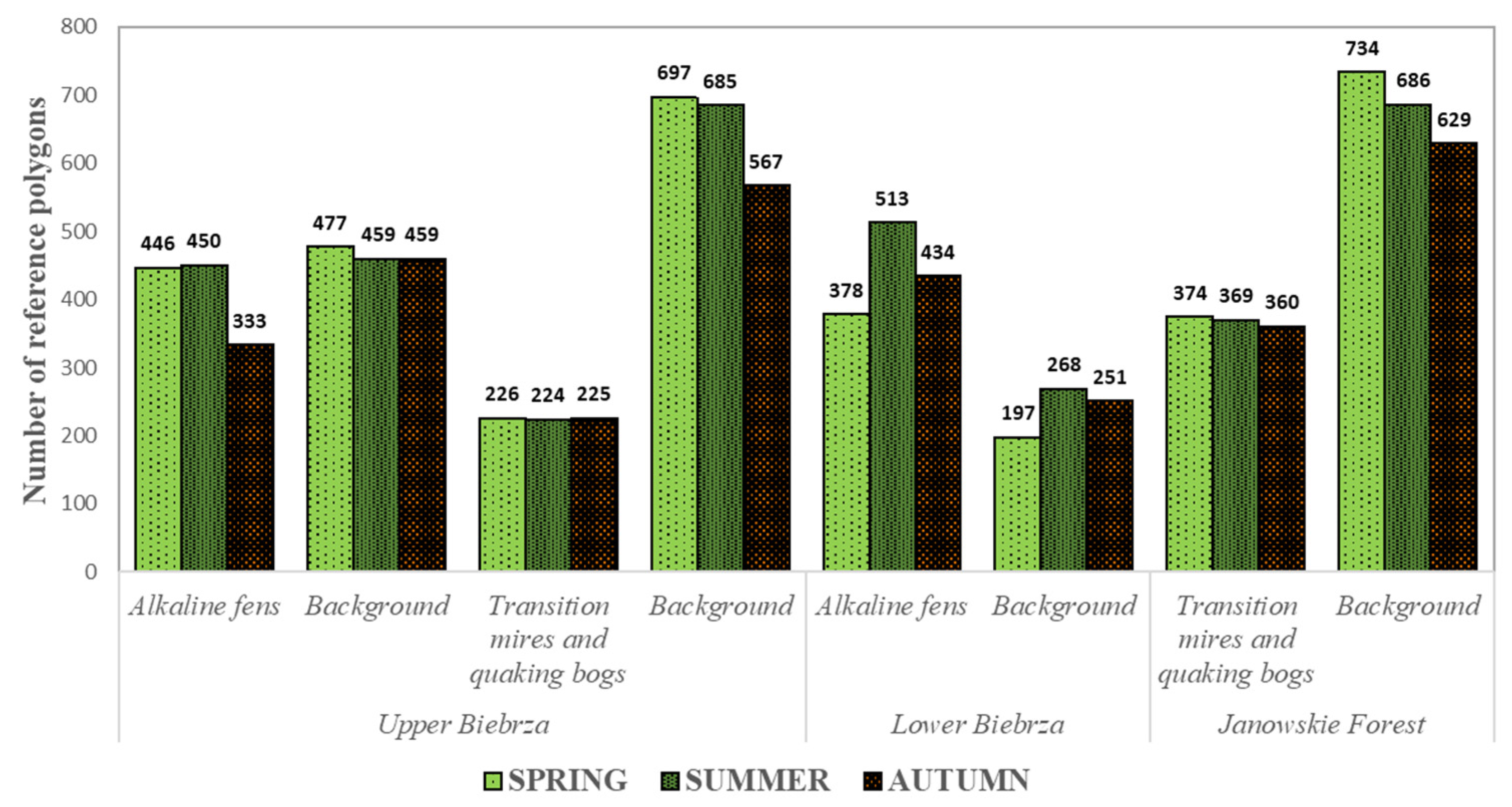

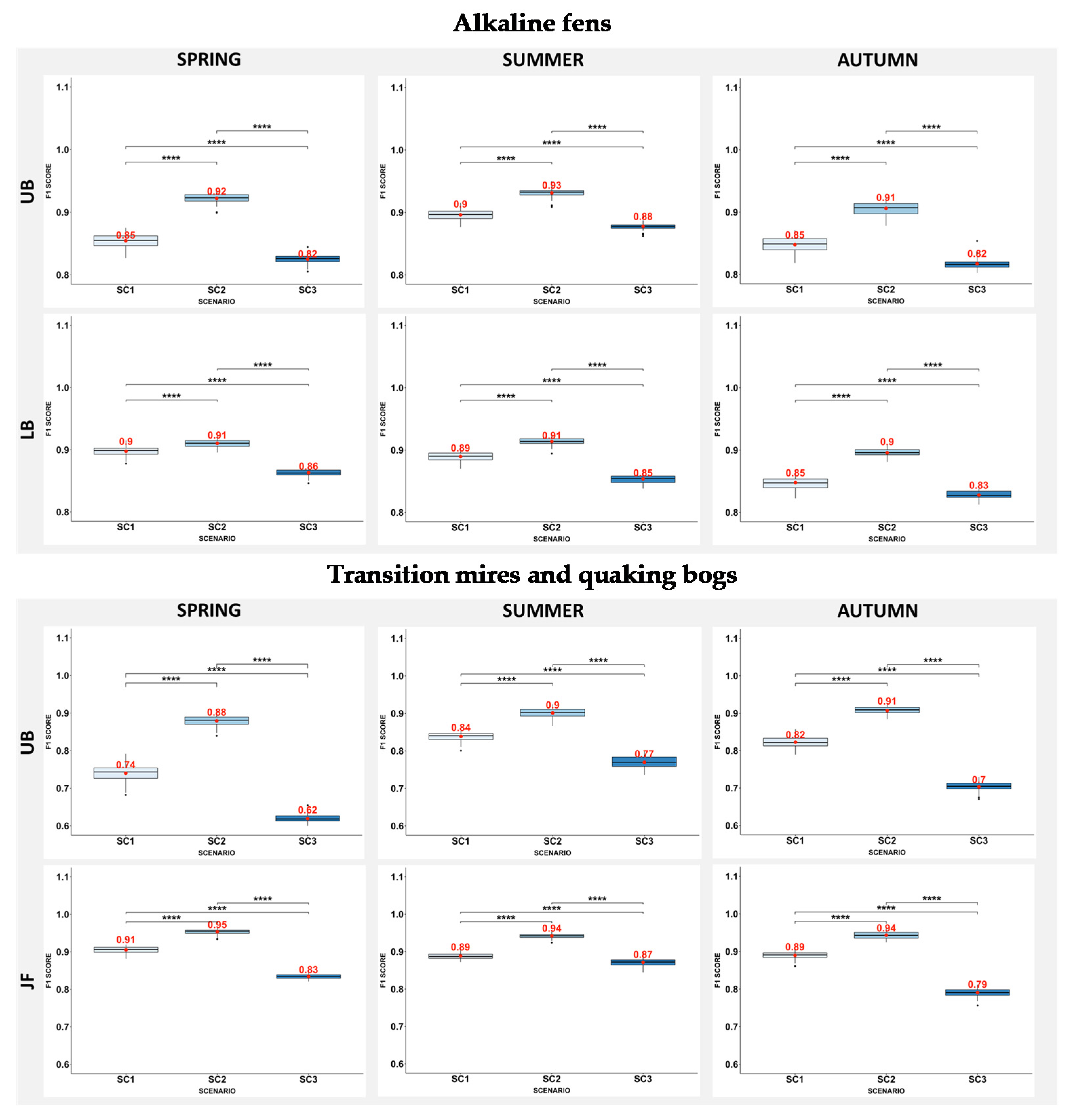
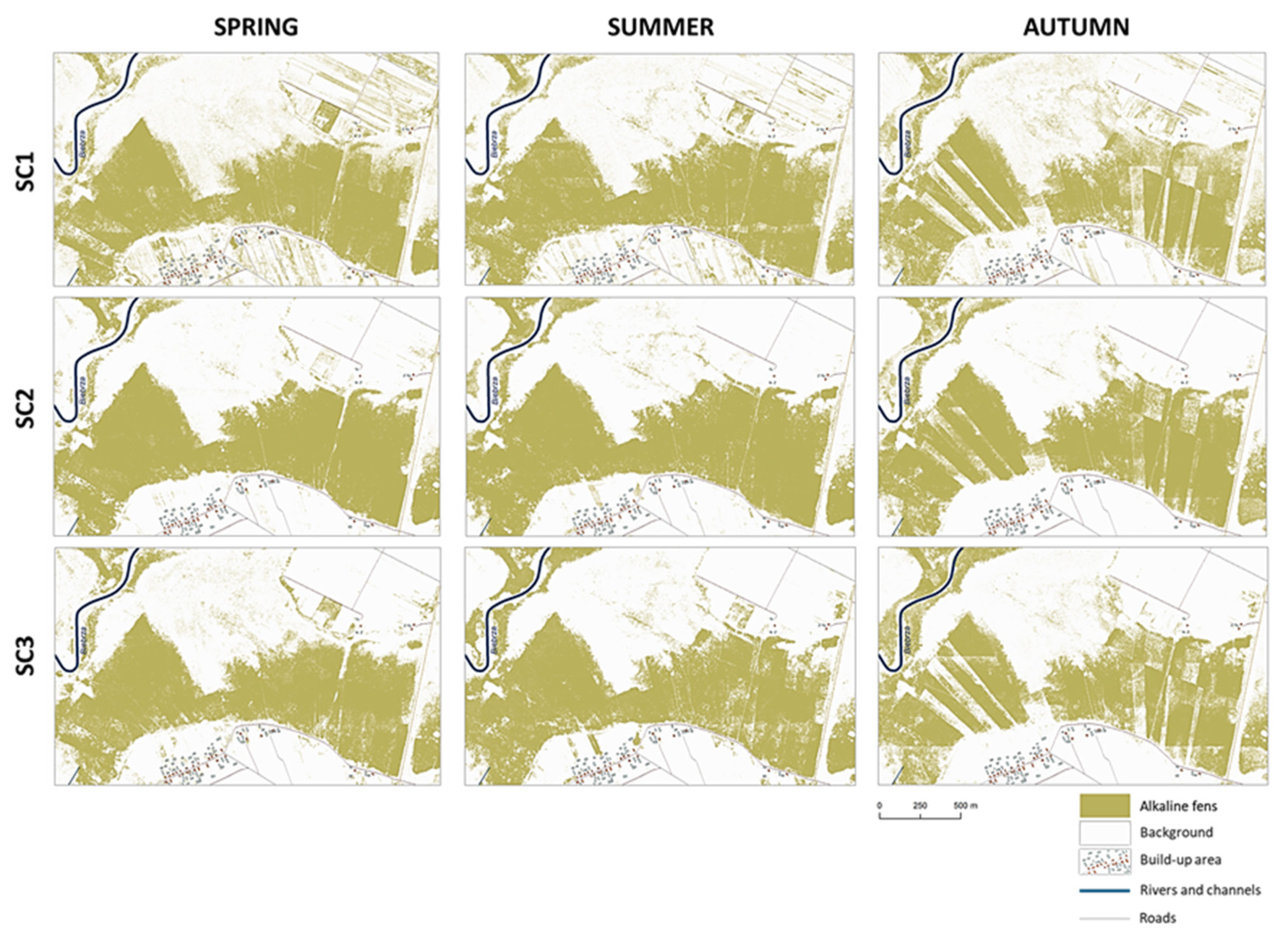




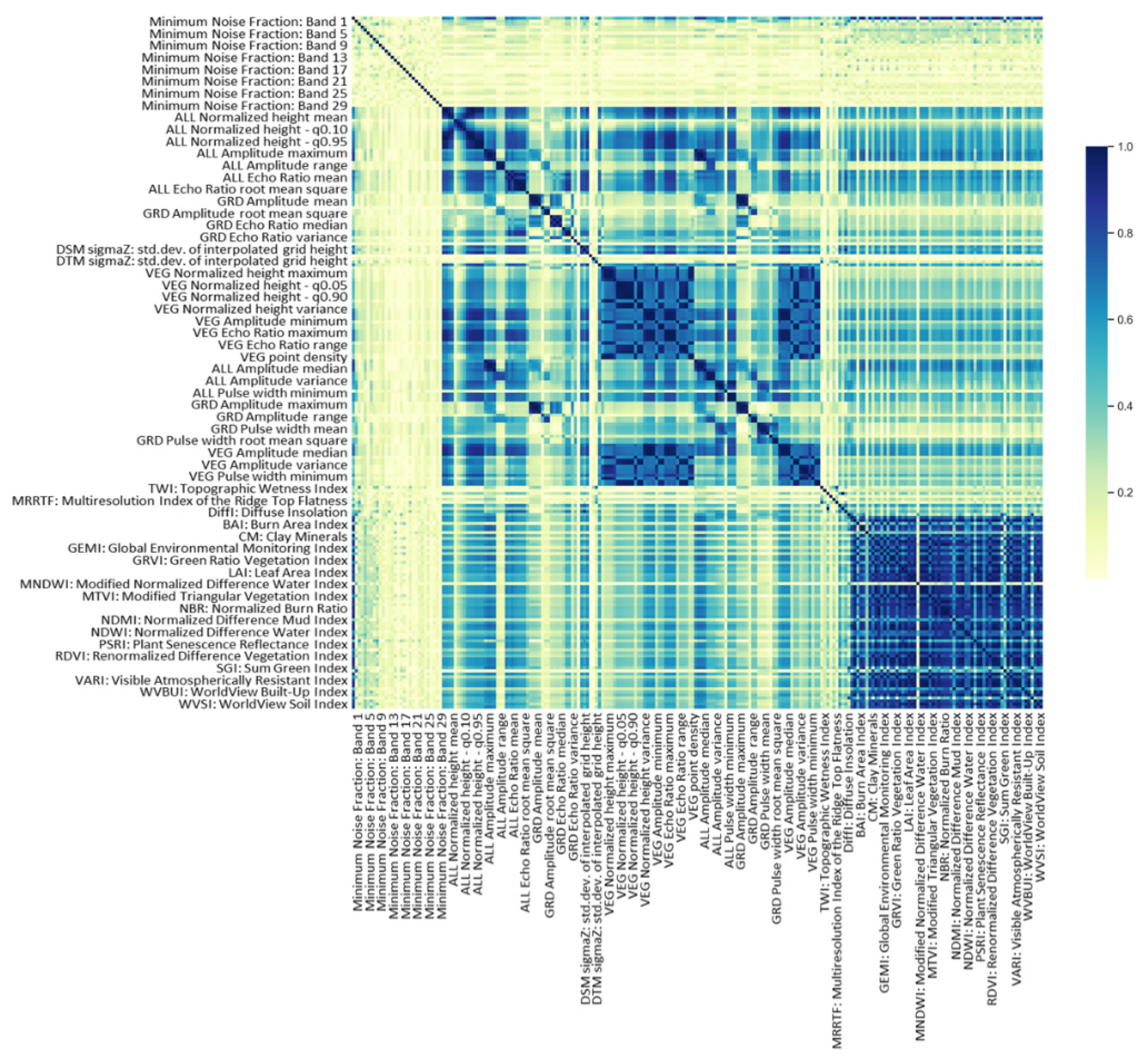

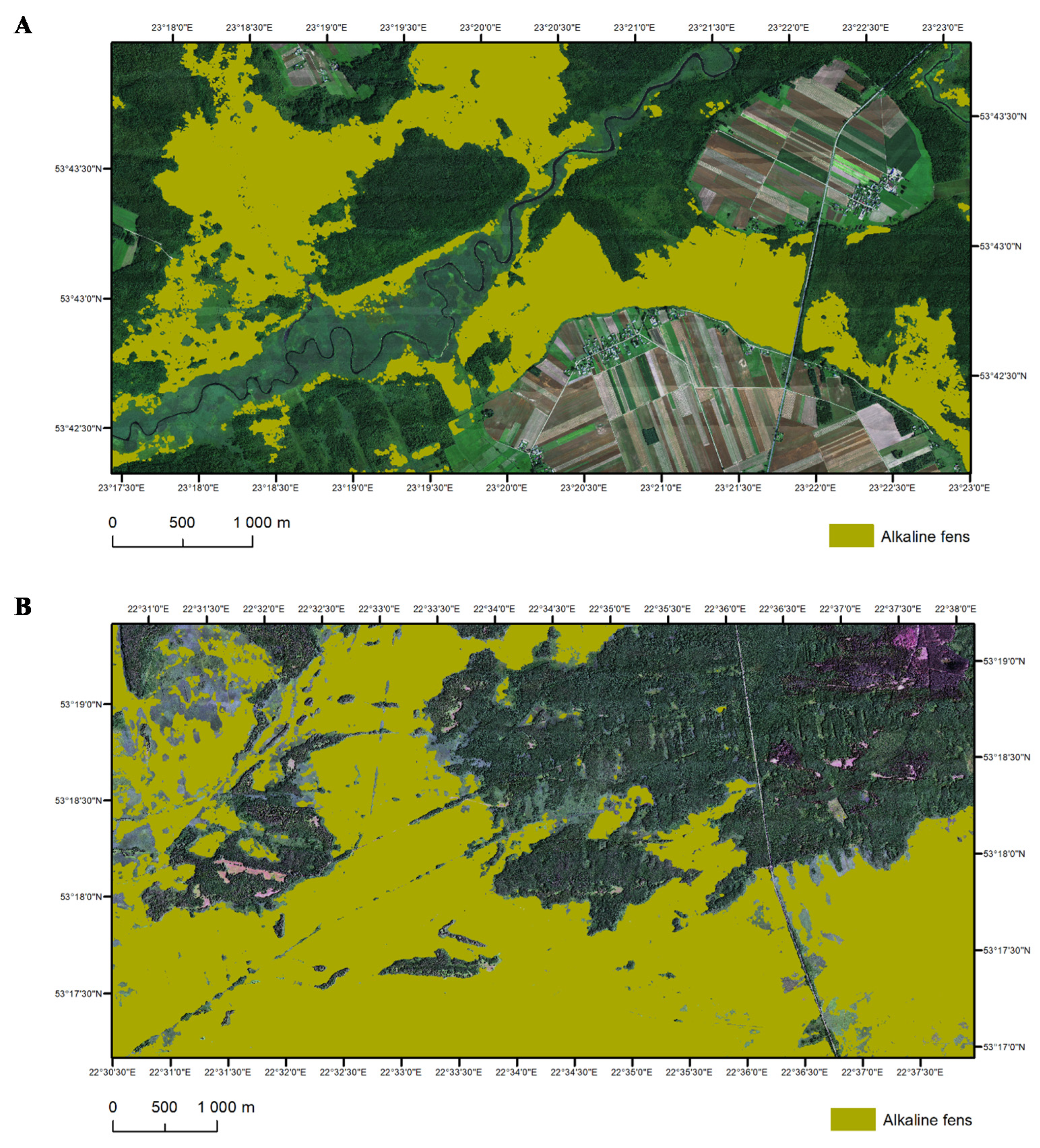
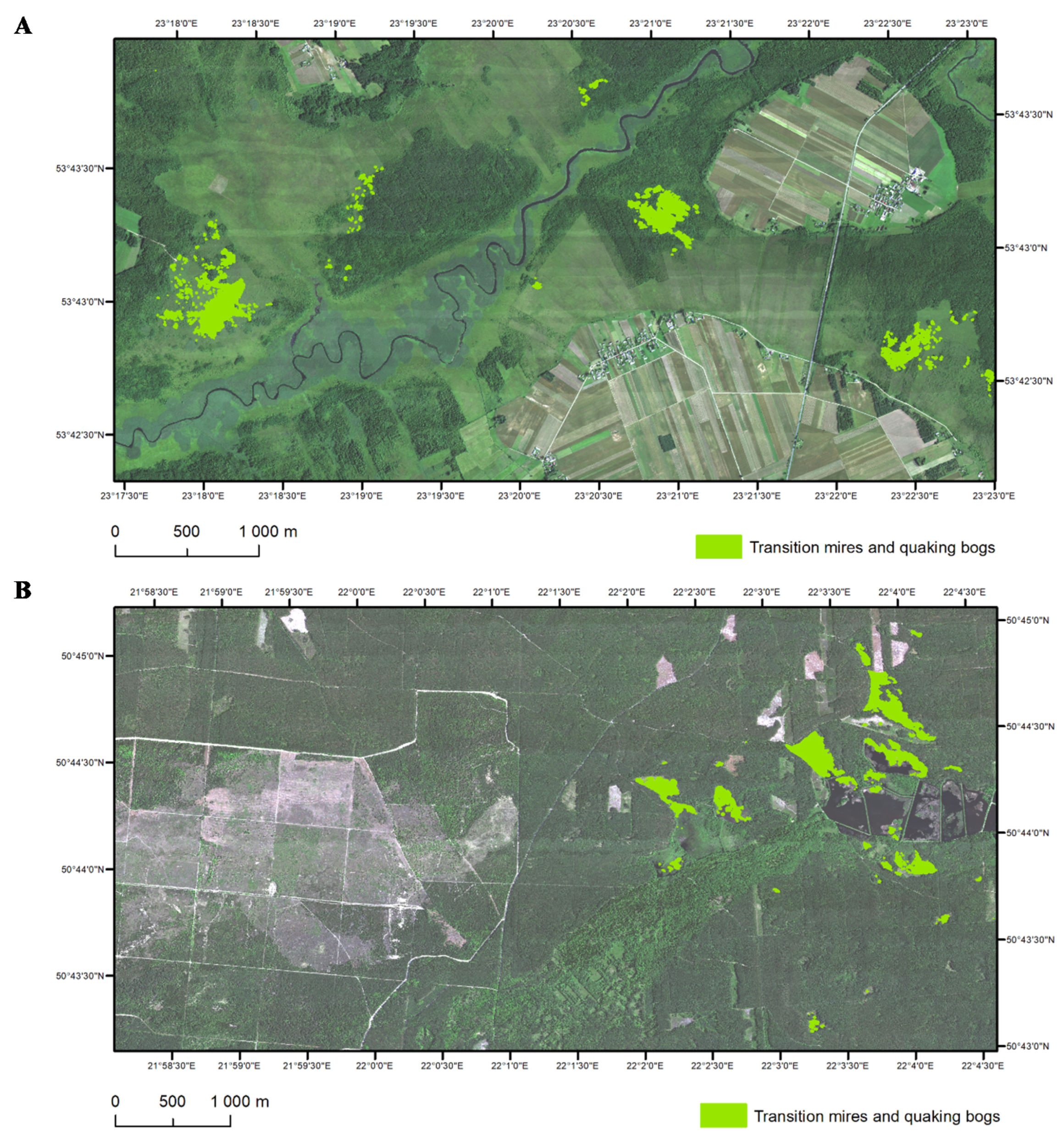
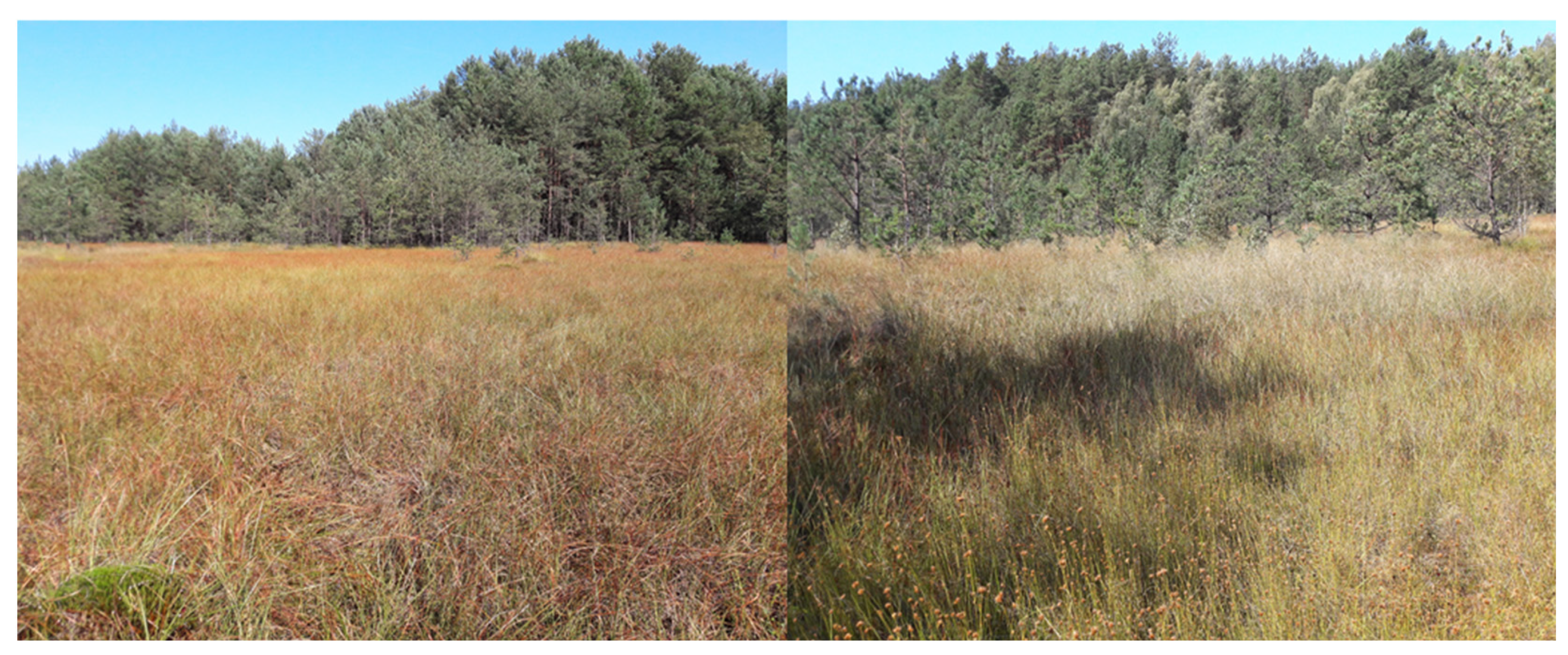
| Name of the Research Area | Area | Data Acquisitions | |||
|---|---|---|---|---|---|
| Data Type | Spring | Summer | Autumn | ||
| Upper Biebrza (UB) | 22 km2 | REMOTELY SENSED | 22.06.2017 | 12.08.2017 | 14.09.2016 |
| BOTANICAL | 30.06.2017 | 19.08.2017 | 03.09.2016 | ||
| Lower Biebrza (LB) | 37 km2 | REMOTELY SENSED | 27.06.2017 | 09.08.2017 | 14.09.2016 |
| BOTANICAL | 28.06.2017 | 16.08.2017 | 06.09.2016 | ||
| Janowskie Forest (JF) | 44 km2 | REMOTELY SENSED | 02.06.2017 | 19.07.2017 | 09.09.2017 |
| BOTANICAL | 07.06.2017 | 27.07.2017 | 05.10.2017 | ||
| Level | Scenario | Data Set |
|---|---|---|
| Level 1 | SC1 | 430 bands of hyperspectral image |
| SC2 | 30 MNF | |
| SC3 | 3 MNF | |
| Level 2 | SC4 | 30 MNF + CHM (Base scenario) |
| SC5 | Base scenario + 83 OPALS Statistical products | |
| SC5 * | Base scenario + 83 OPALS + 42 OPALS FWF Statistical products | |
| SC6 | Base scenario + 9 SAGA Topographic products | |
| SC7 | Base scenario + 65 Spectral Indices | |
| Level 3 | SC8 | Recursive Feature Elimination with Cross-Validation |
| Scenario | Spring | Summer | Autumn | ||||||||
|---|---|---|---|---|---|---|---|---|---|---|---|
| SC1 | SC2 | SC3 | SC1 | SC2 | SC3 | SC1 | SC2 | SC3 | |||
| Area | Stats | Class * | Alkaline Fens | ||||||||
| UB | OA | 0.854 | 0.921 | 0.822 | 0.890 | 0.927 | 0.868 | 0.865 | 0.917 | 0.837 | |
| Kappa | 0.707 | 0.842 | 0.644 | 0.780 | 0.853 | 0.734 | 0.727 | 0.832 | 0.670 | ||
| F1-SCORE | H | 0.854 | 0.922 | 0.825 | 0.896 | 0.931 | 0.878 | 0.848 | 0.906 | 0.817 | |
| UA | H | 0.851 | 0.912 | 0.815 | 0.883 | 0.914 | 0.850 | 0.843 | 0.899 | 0.804 | |
| PA | H | 0.858 | 0.932 | 0.835 | 0.910 | 0.950 | 0.907 | 0.853 | 0.913 | 0.831 | |
| EC | H | 0.149 | 0.088 | 0.185 | 0.117 | 0.086 | 0.150 | 0.157 | 0.101 | 0.196 | |
| EO | H | 0.142 | 0.068 | 0.165 | 0.090 | 0.050 | 0.093 | 0.147 | 0.087 | 0.169 | |
| F1-SCORE | B | 0.852 | 0.920 | 0.819 | 0.883 | 0.921 | 0.856 | 0.879 | 0.926 | 0.853 | |
| UA | B | 0.857 | 0.931 | 0.830 | 0.899 | 0.943 | 0.891 | 0.884 | 0.932 | 0.865 | |
| PA | B | 0.849 | 0.910 | 0.808 | 0.869 | 0.901 | 0.825 | 0.875 | 0.920 | 0.842 | |
| EC | B | 0.143 | 0.069 | 0.170 | 0.101 | 0.057 | 0.109 | 0.116 | 0.068 | 0.135 | |
| EO | B | 0.151 | 0.090 | 0.192 | 0.131 | 0.099 | 0.175 | 0.125 | 0.080 | 0.158 | |
| LB | OA | 0.857 | 0.873 | 0.808 | 0.848 | 0.882 | 0.799 | 0.796 | 0.861 | 0.770 | |
| Kappa | 0.660 | 0.692 | 0.542 | 0.644 | 0.725 | 0.532 | 0.539 | 0.686 | 0.485 | ||
| F1-SCORE | H | 0.898 | 0.910 | 0.863 | 0.890 | 0.914 | 0.854 | 0.848 | 0.896 | 0.827 | |
| UA | H | 0.864 | 0.862 | 0.826 | 0.862 | 0.889 | 0.832 | 0.812 | 0.864 | 0.803 | |
| PA | H | 0.935 | 0.965 | 0.904 | 0.919 | 0.940 | 0.877 | 0.888 | 0.930 | 0.854 | |
| EC | H | 0.136 | 0.138 | 0.174 | 0.138 | 0.111 | 0.168 | 0.188 | 0.136 | 0.197 | |
| EO | H | 0.065 | 0.035 | 0.096 | 0.081 | 0.060 | 0.123 | 0.112 | 0.070 | 0.146 | |
| F1-SCORE | B | 0.761 | 0.779 | 0.676 | 0.754 | 0.810 | 0.677 | 0.688 | 0.789 | 0.657 | |
| UA | B | 0.841 | 0.906 | 0.760 | 0.814 | 0.866 | 0.722 | 0.760 | 0.855 | 0.701 | |
| PA | B | 0.697 | 0.684 | 0.611 | 0.703 | 0.763 | 0.640 | 0.631 | 0.734 | 0.619 | |
| EC | B | 0.159 | 0.094 | 0.240 | 0.186 | 0.134 | 0.278 | 0.240 | 0.145 | 0.299 | |
| EO | B | 0.303 | 0.316 | 0.389 | 0.297 | 0.237 | 0.360 | 0.369 | 0.266 | 0.381 | |
| Area | Stats | Class | Transition Mires and Quaking Bogs | ||||||||
| UB | OA | 0.898 | 0.952 | 0.841 | 0.936 | 0.962 | 0.907 | 0.918 | 0.957 | 0.865 | |
| kappa | 0.677 | 0.849 | 0.509 | 0.799 | 0.877 | 0.712 | 0.769 | 0.879 | 0.616 | ||
| F1-SCORE | H | 0.740 | 0.879 | 0.609 | 0.839 | 0.901 | 0.770 | 0.823 | 0.907 | 0.703 | |
| UA | H | 0.785 | 0.928 | 0.626 | 0.859 | 0.936 | 0.765 | 0.846 | 0.938 | 0.730 | |
| PA | H | 0.702 | 0.836 | 0.594 | 0.820 | 0.869 | 0.775 | 0.802 | 0.878 | 0.680 | |
| EC | H | 0.216 | 0.072 | 0.374 | 0.141 | 0.064 | 0.235 | 0.154 | 0.062 | 0.270 | |
| EO | H | 0.298 | 0.164 | 0.406 | 0.180 | 0.131 | 0.225 | 0.198 | 0.122 | 0.320 | |
| F1-SCORE | B | 0.936 | 0.970 | 0.900 | 0.960 | 0.976 | 0.942 | 0.947 | 0.972 | 0.912 | |
| UA | B | 0.924 | 0.958 | 0.895 | 0.955 | 0.968 | 0.944 | 0.939 | 0.963 | 0.903 | |
| PA | B | 0.949 | 0.983 | 0.906 | 0.966 | 0.985 | 0.940 | 0.954 | 0.982 | 0.922 | |
| EC | B | 0.076 | 0.042 | 0.105 | 0.045 | 0.033 | 0.056 | 0.061 | 0.037 | 0.097 | |
| EO | B | 0.051 | 0.017 | 0.094 | 0.034 | 0.015 | 0.060 | 0.046 | 0.018 | 0.078 | |
| JF | OA | 0.924 | 0.963 | 0.865 | 0.910 | 0.953 | 0.893 | 0.917 | 0.957 | 0.835 | |
| Kappa | 0.842 | 0.923 | 0.721 | 0.813 | 0.903 | 0.780 | 0.824 | 0.908 | 0.655 | ||
| F1-SCORE | H | 0.905 | 0.954 | 0.834 | 0.888 | 0.942 | 0.871 | 0.890 | 0.943 | 0.791 | |
| UA | H | 0.897 | 0.934 | 0.807 | 0.883 | 0.932 | 0.847 | 0.896 | 0.934 | 0.760 | |
| PA | H | 0.914 | 0.974 | 0.864 | 0.894 | 0.953 | 0.898 | 0.883 | 0.953 | 0.824 | |
| EC | H | 0.103 | 0.066 | 0.193 | 0.117 | 0.068 | 0.153 | 0.104 | 0.066 | 0.240 | |
| EO | H | 0.086 | 0.026 | 0.136 | 0.106 | 0.047 | 0.102 | 0.117 | 0.047 | 0.176 | |
| F1-SCORE | B | 0.937 | 0.969 | 0.887 | 0.924 | 0.961 | 0.909 | 0.934 | 0.965 | 0.864 | |
| UA | B | 0.944 | 0.983 | 0.908 | 0.929 | 0.968 | 0.929 | 0.930 | 0.971 | 0.888 | |
| PA | B | 0.931 | 0.956 | 0.866 | 0.920 | 0.953 | 0.890 | 0.938 | 0.959 | 0.842 | |
| EC | B | 0.056 | 0.017 | 0.092 | 0.071 | 0.032 | 0.071 | 0.070 | 0.029 | 0.112 | |
| EO | B | 0.069 | 0.044 | 0.134 | 0.080 | 0.047 | 0.110 | 0.062 | 0.041 | 0.158 | |
| Scenario | Spring | Summer | Autumn | ||||||||||||||
|---|---|---|---|---|---|---|---|---|---|---|---|---|---|---|---|---|---|
| SC4 | SC5 | SC5 * | SC6 | SC7 | SC4 | SC5 | SC5 * | SC6 | SC7 | SC4 | SC5 | SC5 * | SC6 | SC7 | |||
| Area | Stats | Class * | Alkaline fens | ||||||||||||||
| UB | OA | 0.923 | 0.880 | 0.916 | 0.942 | 0.919 | 0.925 | 0.930 | 0.926 | 0.944 | 0.923 | 0.926 | 0.927 | N/A | 0.937 | 0.898 | |
| Kappa | 0.845 | 0.761 | 0.833 | 0.885 | 0.837 | 0.849 | 0.859 | 0.851 | 0.888 | 0.845 | 0.850 | 0.853 | N/A | 0.873 | 0.795 | ||
| F1-SCORE | H | 0.923 | 0.881 | 0.918 | 0.943 | 0.919 | 0.929 | 0.934 | 0.930 | 0.948 | 0.927 | 0.916 | 0.918 | N/A | 0.929 | 0.886 | |
| UA | H | 0.917 | 0.880 | 0.903 | 0.939 | 0.914 | 0.913 | 0.922 | 0.918 | 0.935 | 0.914 | 0.911 | 0.912 | N/A | 0.921 | 0.869 | |
| PA | H | 0.929 | 0.882 | 0.934 | 0.947 | 0.925 | 0.947 | 0.947 | 0.942 | 0.961 | 0.942 | 0.922 | 0.925 | N/A | 0.939 | 0.904 | |
| EC | H | 0.083 | 0.120 | 0.097 | 0.061 | 0.086 | 0.087 | 0.078 | 0.082 | 0.065 | 0.086 | 0.089 | 0.088 | N/A | 0.079 | 0.131 | |
| EO | H | 0.071 | 0.118 | 0.066 | 0.053 | 0.075 | 0.053 | 0.053 | 0.058 | 0.039 | 0.058 | 0.078 | 0.075 | N/A | 0.061 | 0.096 | |
| F1-SCORE | B | 0.922 | 0.880 | 0.914 | 0.942 | 0.918 | 0.919 | 0.925 | 0.921 | 0.940 | 0.918 | 0.934 | 0.935 | N/A | 0.944 | 0.908 | |
| UA | B | 0.929 | 0.881 | 0.932 | 0.945 | 0.924 | 0.939 | 0.940 | 0.935 | 0.956 | 0.934 | 0.939 | 0.940 | N/A | 0.951 | 0.923 | |
| PA | B | 0.916 | 0.878 | 0.898 | 0.938 | 0.912 | 0.901 | 0.911 | 0.908 | 0.926 | 0.902 | 0.929 | 0.930 | N/A | 0.936 | 0.894 | |
| EC | B | 0.071 | 0.119 | 0.068 | 0.055 | 0.076 | 0.061 | 0.060 | 0.065 | 0.044 | 0.066 | 0.061 | 0.060 | N/A | 0.049 | 0.077 | |
| EO | B | 0.084 | 0.122 | 0.102 | 0.062 | 0.088 | 0.099 | 0.089 | 0.092 | 0.074 | 0.098 | 0.071 | 0.070 | N/A | 0.064 | 0.106 | |
| LB | OA | 0.878 | 0.882 | 0.889 | 0.876 | 0.899 | 0.881 | 0.903 | 0.790 | 0.908 | 0.798 | 0.876 | 0.875 | N/A | 0.800 | 0.857 | |
| Kappa | 0.705 | 0.719 | 0.737 | 0.704 | 0.761 | 0.723 | 0.773 | 0.513 | 0.786 | 0.524 | 0.727 | 0.722 | N/A | 0.556 | 0.684 | ||
| F1-SCORE | H | 0.914 | 0.917 | 0.921 | 0.912 | 0.928 | 0.913 | 0.929 | 0.848 | 0.933 | 0.854 | 0.906 | 0.905 | N/A | 0.847 | 0.892 | |
| UA | H | 0.868 | 0.877 | 0.883 | 0.873 | 0.896 | 0.889 | 0.904 | 0.827 | 0.912 | 0.825 | 0.875 | 0.869 | N/A | 0.818 | 0.858 | |
| PA | H | 0.965 | 0.960 | 0.963 | 0.956 | 0.963 | 0.940 | 0.956 | 0.870 | 0.956 | 0.886 | 0.940 | 0.944 | N/A | 0.879 | 0.929 | |
| EC | H | 0.132 | 0.123 | 0.117 | 0.127 | 0.104 | 0.111 | 0.096 | 0.173 | 0.088 | 0.175 | 0.125 | 0.131 | N/A | 0.182 | 0.142 | |
| EO | H | 0.035 | 0.040 | 0.037 | 0.044 | 0.037 | 0.060 | 0.044 | 0.130 | 0.044 | 0.114 | 0.060 | 0.056 | N/A | 0.121 | 0.071 | |
| F1-SCORE | B | 0.789 | 0.801 | 0.814 | 0.790 | 0.833 | 0.809 | 0.843 | 0.664 | 0.852 | 0.668 | 0.820 | 0.816 | N/A | 0.708 | 0.791 | |
| UA | B | 0.908 | 0.898 | 0.908 | 0.888 | 0.909 | 0.863 | 0.901 | 0.705 | 0.899 | 0.728 | 0.882 | 0.888 | N/A | 0.762 | 0.859 | |
| PA | B | 0.699 | 0.724 | 0.739 | 0.714 | 0.769 | 0.763 | 0.793 | 0.630 | 0.810 | 0.618 | 0.768 | 0.756 | N/A | 0.663 | 0.734 | |
| EC | B | 0.092 | 0.102 | 0.092 | 0.112 | 0.091 | 0.137 | 0.099 | 0.295 | 0.101 | 0.272 | 0.118 | 0.112 | N/A | 0.238 | 0.141 | |
| EO | B | 0.301 | 0.276 | 0.261 | 0.286 | 0.231 | 0.237 | 0.207 | 0.370 | 0.190 | 0.382 | 0.232 | 0.244 | N/A | 0.337 | 0.266 | |
| Area | Stats | Class | Transition Mires and Quaking Bogs | ||||||||||||||
| UB | OA | 0.951 | 0.928 | 0.949 | 0.963 | 0.948 | 0.961 | 0.961 | 0.958 | 0.971 | 0.959 | 0.959 | 0.954 | N/A | 0.966 | 0.946 | |
| KAPPA | 0.847 | 0.776 | 0.838 | 0.882 | 0.837 | 0.877 | 0.874 | 0.866 | 0.908 | 0.867 | 0.885 | 0.870 | N/A | 0.905 | 0.848 | ||
| F1-SCORE | H | 0.877 | 0.821 | 0.869 | 0.905 | 0.869 | 0.900 | 0.899 | 0.891 | 0.926 | 0.892 | 0.912 | 0.900 | N/A | 0.927 | 0.884 | |
| UA | H | 0.931 | 0.847 | 0.927 | 0.945 | 0.919 | 0.933 | 0.943 | 0.937 | 0.951 | 0.926 | 0.950 | 0.949 | N/A | 0.963 | 0.918 | |
| PA | H | 0.830 | 0.799 | 0.819 | 0.870 | 0.824 | 0.871 | 0.859 | 0.851 | 0.903 | 0.862 | 0.876 | 0.856 | N/A | 0.895 | 0.853 | |
| EC | H | 0.069 | 0.153 | 0.073 | 0.055 | 0.081 | 0.067 | 0.057 | 0.063 | 0.049 | 0.074 | 0.050 | 0.051 | N/A | 0.037 | 0.082 | |
| EO | H | 0.170 | 0.201 | 0.181 | 0.130 | 0.176 | 0.129 | 0.141 | 0.149 | 0.097 | 0.138 | 0.124 | 0.144 | N/A | 0.105 | 0.147 | |
| F1-SCORE | B | 0.970 | 0.955 | 0.968 | 0.977 | 0.968 | 0.976 | 0.976 | 0.974 | 0.982 | 0.974 | 0.973 | 0.970 | N/A | 0.978 | 0.965 | |
| UA | B | 0.956 | 0.948 | 0.954 | 0.967 | 0.955 | 0.968 | 0.965 | 0.963 | 0.976 | 0.966 | 0.962 | 0.956 | N/A | 0.967 | 0.954 | |
| PA | B | 0.984 | 0.962 | 0.983 | 0.987 | 0.981 | 0.984 | 0.987 | 0.986 | 0.988 | 0.983 | 0.985 | 0.985 | N/A | 0.989 | 0.975 | |
| EC | B | 0.044 | 0.052 | 0.046 | 0.033 | 0.045 | 0.032 | 0.035 | 0.037 | 0.024 | 0.034 | 0.038 | 0.044 | N/A | 0.033 | 0.046 | |
| EO | B | 0.016 | 0.038 | 0.017 | 0.013 | 0.019 | 0.016 | 0.013 | 0.014 | 0.012 | 0.017 | 0.015 | 0.015 | N/A | 0.011 | 0.025 | |
| JF | OA | 0.962 | 0.964 | 0.963 | 0.962 | 0.960 | 0.953 | 0.949 | 0.953 | 0.955 | 0.946 | 0.960 | 0.955 | 0.955 | 0.960 | 0.955 | |
| Kappa | 0.921 | 0.925 | 0.923 | 0.920 | 0.916 | 0.903 | 0.895 | 0.903 | 0.908 | 0.888 | 0.915 | 0.905 | 0.904 | 0.914 | 0.904 | ||
| F1-SCORE | H | 0.953 | 0.955 | 0.954 | 0.952 | 0.950 | 0.942 | 0.938 | 0.943 | 0.946 | 0.933 | 0.947 | 0.941 | 0.941 | 0.947 | 0.941 | |
| UA | H | 0.931 | 0.936 | 0.933 | 0.932 | 0.933 | 0.928 | 0.920 | 0.931 | 0.932 | 0.922 | 0.940 | 0.937 | 0.931 | 0.936 | 0.933 | |
| PA | H | 0.976 | 0.975 | 0.976 | 0.974 | 0.967 | 0.957 | 0.958 | 0.955 | 0.960 | 0.945 | 0.955 | 0.945 | 0.951 | 0.959 | 0.949 | |
| EC | H | 0.069 | 0.064 | 0.067 | 0.068 | 0.067 | 0.072 | 0.080 | 0.069 | 0.068 | 0.078 | 0.060 | 0.063 | 0.069 | 0.064 | 0.067 | |
| EO | H | 0.024 | 0.025 | 0.024 | 0.026 | 0.033 | 0.043 | 0.042 | 0.045 | 0.040 | 0.055 | 0.045 | 0.055 | 0.049 | 0.041 | 0.051 | |
| F1-SCORE | B | 0.969 | 0.970 | 0.969 | 0.968 | 0.967 | 0.960 | 0.957 | 0.960 | 0.962 | 0.955 | 0.968 | 0.964 | 0.963 | 0.967 | 0.964 | |
| UA | B | 0.984 | 0.983 | 0.984 | 0.982 | 0.978 | 0.971 | 0.971 | 0.969 | 0.973 | 0.963 | 0.973 | 0.966 | 0.970 | 0.975 | 0.969 | |
| PA | B | 0.954 | 0.957 | 0.954 | 0.954 | 0.955 | 0.950 | 0.943 | 0.952 | 0.952 | 0.947 | 0.963 | 0.962 | 0.957 | 0.960 | 0.958 | |
| EC | B | 0.016 | 0.017 | 0.016 | 0.018 | 0.022 | 0.029 | 0.029 | 0.031 | 0.027 | 0.037 | 0.027 | 0.034 | 0.030 | 0.025 | 0.031 | |
| EO | B | 0.046 | 0.043 | 0.046 | 0.046 | 0.045 | 0.050 | 0.057 | 0.048 | 0.048 | 0.053 | 0.037 | 0.038 | 0.043 | 0.040 | 0.042 | |
| Alkaline Fens in the Biebrza River Valley (UB and LB Areas) | |||||||||||||
|---|---|---|---|---|---|---|---|---|---|---|---|---|---|
| Area | Data Acquisition Time | OA | Kappa | UA | PA | F1-SCORE | EC | EO | UA | PA | F1-SCORE | EC | EO |
| H | H | H | H | H | B | B | B | B | B | ||||
| UB | Summer | 0.946 | 0.892 | 0.935 | 0.966 | 0.950 | 0.065 | 0.035 | 0.960 | 0.925 | 0.942 | 0.040 | 0.075 |
| LB | Summer | 0.910 | 0.790 | 0.910 | 0.961 | 0.935 | 0.090 | 0.039 | 0.911 | 0.806 | 0.855 | 0.089 | 0.194 |
| Transition Mires and Quaking in the Upper Biebrza River Valley (UB Area) | |||||||||||||
| Area | Data Acquisition Time | OA | Kappa | UA | PA | F1-SCORE | EC | EO | UA | PA | F1-SCORE | EC | EO |
| H | H | H | H | H | B | B | B | B | B | ||||
| UB | Summer | 0.973 | 0.914 | 0.962 | 0.901 | 0.931 | 0.038 | 0.099 | 0.976 | 0.991 | 0.983 | 0.024 | 0.009 |
| Autumn | 0.963 | 0.899 | 0.967 | 0.883 | 0.923 | 0.033 | 0.117 | 0.962 | 0.990 | 0.975 | 0.038 | 0.010 | |
| Transition Mires and Quaking in the Janowskie Forest (JF Area) | |||||||||||||
| Area | Data Acquisition Time | OA | Kappa | UA | PA | F1-SCORE | EC | EO | UA | PA | F1-SCORE | EC | EO |
| H | H | H | H | H | B | B | B | B | B | ||||
| JF | Spring | 0.962 | 0.921 | 0.934 | 0.973 | 0.953 | 0.066 | 0.027 | 0.982 | 0.955 | 0.968 | 0.018 | 0.045 |
| Summer | 0.957 | 0.912 | 0.936 | 0.961 | 0.948 | 0.065 | 0.039 | 0.973 | 0.955 | 0.960 | 0.027 | 0.045 | |
| Type of Data Set | Feature Type | Full Name | Dataset | Category | References |
|---|---|---|---|---|---|
| Hyperspectral Transformation Products | 30MNF | Minimum Noise Fraction | Hyperspectral data | Dimension reduction technique | [62] |
| ALS Topograhic Products | MRRTF | Multiresolution Index of the Ridge Top Flatness | DTM | Morphology | [72] |
| DurI | Duration of Insolation | DSM | Solar radiation availability | [73] | |
| TPI | Topographic Position Index | DTM | Morphology | [74] | |
| DiffI | Diffuse Insolation | DSM | Solar radiation availability | [73] | |
| TWI | Topographic Wetness Index | DTM | Wetness | [75] | |
| MCA | Modified Catchment Area | DTM | Wetness | [76] | |
| MRVBF | Multiresolution Index of Valley Bottom Flatness | DTM | Morphology | [72] | |
| TI | Total insolation | DSM | Solar radiation availability | [73] | |
| DirI | Direct Insolation | DSM | Solar radiation availability | [73] | |
| Spectral Indices | ARI1 | Anthocyanin Reflectance Index 1 | 550.4 nm 700.6 nm | Leaf Pigments | [77] |
| ARI2 | Anthocyanin Reflectance Index 2 | 799.7 nm 550.4 nm 700.6 nm | Leaf Pigments | [77] | |
| CRI2 | Carotenoid Reflectance Index 2 | 508.9 nm 700.6 nm | Leaf Pigments | [77] | |
| EVI | Enhanced Vegetation Index | 860.4 nm 652.7 nm 470.5 nm | Greenness | [78] | |
| PRI | Photochemical Reflectance Index | 531.2 nm 569.6 nm | Light Use Efficiency | [79,80] | |
| MNDWI | Modified Normalized Difference Water Index | 550.4 nm 1653.4 nm | Wetness | [81,82] | |
| RENDVI | Red Edge Normalized Difference Vegetation Index | 748.6 nm 703.8 nm | Greenness | [83,84] | |
| ALS Statistical Products | DTM | Exposition, Slope, SigmaZ, Variance | LiDAR DATA | Ground class | [66] |
| DSM | Exposition, SigmaZ, Sigma0 | LiDAR DATA | ALL: Ground and Vegetation class | [66] | |
| NormalizedZ_min | Normalized height minimum | LiDAR DATA | ALL: Ground and Vegetation class | [66] | |
| NormalizedZ_var | Normalized height variance | LiDAR DATA | Vegetation class | [66] | |
| CHM | Canopy Height Model | LiDAR DATA | Vegetation class | [66] | |
| Point density | Number of pts/m2 | LiDAR DATA | Ground class | [66] |
| Type of DATA Set | Feature Type | Full Name | Dataset | Category | References |
|---|---|---|---|---|---|
| Hyperspectral Transformation Products | 30MNF | Minimum Noise Fraction | Hyperspectral data | Dimension reduction technique | [62] |
| ALS Topograhic Products | MRRTF | Multiresolution Index of the Ridge Top Flatness | DTM | Morphology | [72] |
| TPI | Topographic Position Index | DTM | Morphology | [74] | |
| TWI | Topographic Wetness Index | DTM | Wetness | [75] | |
| MRVBF | Multiresolution Index of Valley Bottom Flatness | DTM | Morphology | [72] | |
| TI | Total insolation | DSM | Solar radiation availability | [73] | |
| ALS Statistical Products | DTM | Exposition, Slope, Sigma0, SigmaZ | LiDAR DATA | Ground class | [66] |
| DSM | Exposition, Slope, Sigma Z | LiDAR DATA | Vegetation class | [66] | |
| NormalizedZ_var | Normalized height variance | LiDAR DATA | Vegetation class | [66] | |
| CHM | Canopy Height Model | LiDAR DATA | Vegetation class | [66] | |
| Spectral Indices | ARI1 | Anthocyanin Reflectance Index 1 | 550.4 nm 700.6 nm | Leaf Pigments | [77] |
| PRI | Photochemical Reflectance Index | 531.2 nm 569.6 nm | Light Use Efficiency | [79,80] | |
| MNDWI | Modified Normalized Difference Water Index | 550.4 nm 1653.4 nm | Wetness | [81,82] | |
| NDMI | Normalized Difference Mud Index | 796.5 nm 991.8 nm | Wetness | [85] | |
| NMDI | Normalized Multi-band Drought Index | 860.4 nm 1642.6 nm 2130.7 nm | Canopy Water Content | [86,87] | |
| IO | Iron Oxide Ratio | 652.7 nm 470.5 nm | Geology | [88,89] | |
| DVI | Difference Vegetation Index | 860.4 nm 652.7 nm | Greenness | [90] | |
| CAI | Cellulose Absorption Index | 2000.5 nm 2201.2 nm | Necromass | [91,92] |
| Type OF Data Set | Feature Type | Full Name | Dataset | Category | References |
|---|---|---|---|---|---|
| Hyperspectral Transformation Products | 30MNF | Minimum Noise Fraction | Hyperspectral data | Dimension reduction technique | [62] |
| ALSTopograhic Products | MRRTF | Multiresolution Index of the Ridge Top Flatness | DTM | Morphology | [72] |
| TPI | Topographic Position Index | DTM | Morphology | [74] | |
| TWI | Topographic Wetness Index | DTM | Wetness | [75] | |
| MRVBF | Multiresolution Index of Valley Bottom Flatness | DTM | Morphology | [72] | |
| TI | Total insolation | DSM | Solar radiation availability | [73] | |
| ALS Statistical Products | DTM | Exposition, Slope, Sigma0, SigmaZ | LiDAR DATA | Ground class | [66] |
| DSM | Exposition, Slope | LiDAR DATA | Vegetation class | [66] | |
| CHM | Canopy Height Model | LiDAR DATA | Vegetation class | [66] | |
| Spectral Indices | ARVI | Atmospherically Resistant Vegetation Index | 799.7 nm 681.4 nm 444.9 nm | Greenness | [93] |
| IO | Iron Oxide Ratio | 652.7 nm 470.5 nm | Geology | [88,89] | |
| ARI2 | Anthocyanin Reflectance Index 2 | 799.7 nm 550.4 nm 700.6 nm | Leaf Pigments | [77] | |
| ARI1 | Anthocyanin Reflectance Index 1 | 550.4 nm 700.6 nm | Leaf Pigments | [77] | |
| FM | Ferrous Minerals Ratio | 1648.0 nm 860.4 nm | Geology | [88,89] |
Publisher’s Note: MDPI stays neutral with regard to jurisdictional claims in published maps and institutional affiliations. |
© 2021 by the authors. Licensee MDPI, Basel, Switzerland. This article is an open access article distributed under the terms and conditions of the Creative Commons Attribution (CC BY) license (https://creativecommons.org/licenses/by/4.0/).
Share and Cite
Szporak-Wasilewska, S.; Piórkowski, H.; Ciężkowski, W.; Jarzombkowski, F.; Sławik, Ł.; Kopeć, D. Mapping Alkaline Fens, Transition Mires and Quaking Bogs Using Airborne Hyperspectral and Laser Scanning Data. Remote Sens. 2021, 13, 1504. https://doi.org/10.3390/rs13081504
Szporak-Wasilewska S, Piórkowski H, Ciężkowski W, Jarzombkowski F, Sławik Ł, Kopeć D. Mapping Alkaline Fens, Transition Mires and Quaking Bogs Using Airborne Hyperspectral and Laser Scanning Data. Remote Sensing. 2021; 13(8):1504. https://doi.org/10.3390/rs13081504
Chicago/Turabian StyleSzporak-Wasilewska, Sylwia, Hubert Piórkowski, Wojciech Ciężkowski, Filip Jarzombkowski, Łukasz Sławik, and Dominik Kopeć. 2021. "Mapping Alkaline Fens, Transition Mires and Quaking Bogs Using Airborne Hyperspectral and Laser Scanning Data" Remote Sensing 13, no. 8: 1504. https://doi.org/10.3390/rs13081504
APA StyleSzporak-Wasilewska, S., Piórkowski, H., Ciężkowski, W., Jarzombkowski, F., Sławik, Ł., & Kopeć, D. (2021). Mapping Alkaline Fens, Transition Mires and Quaking Bogs Using Airborne Hyperspectral and Laser Scanning Data. Remote Sensing, 13(8), 1504. https://doi.org/10.3390/rs13081504








